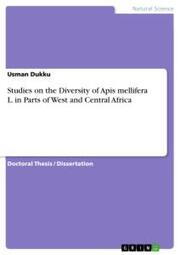Detailansicht
Studies on the Diversity of Apis mellifera L. in Parts of West and Central Africa
ISBN/EAN: 9783346090782
Umbreit-Nr.: 8685744
Sprache:
Englisch
Umfang: 172 S., 22 farbige Illustr.
Format in cm: 1.3 x 21 x 14.8
Einband:
kartoniertes Buch
Erschienen am 09.12.2019
Auflage: 1/2019
- Zusatztext
- Doctoral Thesis / Dissertation from the year 2015 in the subject Biology - Zoology, grade: 2.0, University of Frankfurt (Main), language: English, abstract: In order to investigate the diversity of the western honeybee, Apis mellifera L., in West and Central Africa, a total of 204 colonies were sampled from 44 localities in four countries - Nigeria, Niger, Cameroon and Chad. 86 of these colonies, from 23 localities, were subjected to full morphometric analysis. In a stepwise DA, 94.2% of cross-validated grouped cases were correctly classified and the distances between group centroids were highly significant according to F-statistic. 61 and 22 of the 83 colonies under investigation were assigned to A. m. jemenitica and A. m. adansonii, respectively. Mitochondrial DNA analysis was carried out on 148 colonies from 39 localities. Four mitochondrial haplotypes, previously reported from Africa and belonging to the African mitochondrial lineage, A, were detected: A1 (n = 62), A4 (n = 70), A4' (n = 15) and A14 (n = 1). 133 workers (one per colony) collected from 38 localities were subjected to microsatellite analysis. A total of 292 different alleles were recorded for the 15 microsatellite loci used. All microsatellite loci were polymorphic and the number of different alleles per locus ranged between 10, in locus At163, and 31, in locus A029. Heterozygosity (or gene diversity) was high in all loci. The unbiased expected heterozygosity, which is a better expression of gene diversity, was 0.861 ± S.E. 0.017. The overall FST value, which is a good estimate of genetic differentiation of populations, was very low: 0.007 ± S.E. 0.001 (0.001 - 0.014). AMOVA and Bayesian assignment showed no differentiation of the investigated populations. Based on morphometric analysis, the results of this study present the honeybees of western Africa as a single entity with an internal variation which lacks a geographical demarcation. Consequently the results do not support the splitting of the honeybees of the region into the two subspecies, A. m. adansonii and A. m. jemenitica, as reported in the literature. More morphometric, molecular, physiological and behavioural studies are required to confirm the taxonomic status of the honeybees of the region. Meanwhile, the use of A. m. adansonii, as the sole sub-specific name for the honeybees of West and Central Africa, is recommended.
